Blog
Our goal is to provide you with valuable insights and practical tips that can help you increase your online visibility, attract more leads, and ultimately drive revenue growth.
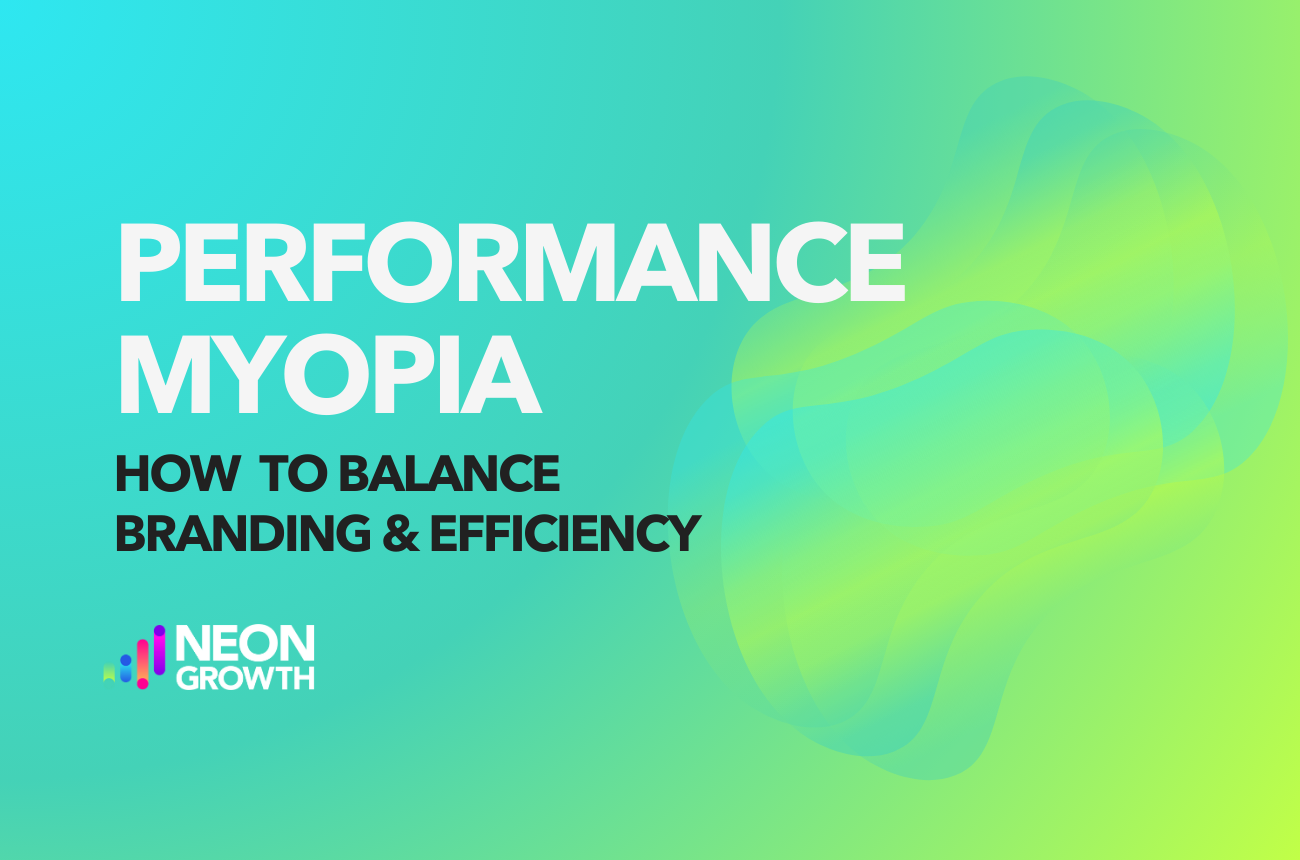
Performance Myopia: How to Balance Branding & Efficiency
Performance Myopia happens when marketing teams place too much emphasis on making performance metrics look good, and not enough long-term brand profitability.
Owners, CMOs & VPs of Marketing responsible for driving results in the long-term need to understand the signs of performance myopia and how to correct it.
It's something we see time and time again in ad accounts. The effects were also captured recently in a study by Kantar.
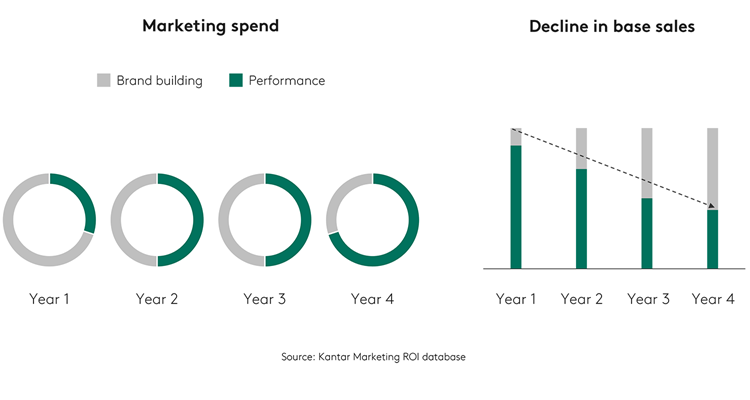
When brands become transactional in their advertising, it customers take notice. A lot of the brand's magic is lost in translation.
Why Performance Myopia happens:
- Short-Sighted Agencies: Often motivated toward short-term ad budget increases, wins to report this week, and junior reps with limited knowledge of brand building & business economics.
- Ambitious In-House Marketers: Often in roles for <2 years, interested in making short-term gains for promotions and recognition, less invested in long-term outcomes.
- Conflicting Interests: When teams separately manage ad channels, they often compete for resources. This incentivizes each team to make their efforts appear more successful to justify more budget.
- Data Misinterpretation: Relying on the wrong data signals to guide creative, channel and/or budget allocation strategy.
Key Signs of Performance Myopia:
While Kantar focuses on creative analysis, campaign structures and technical setup also excerbate the decline.
- Topline revenue growth not keeping pace with ad budgets
- Shrinking top of funnel reaching fewer unique new customers.
- ROAS looks better initially but attribution doesn’t add up.
- Lifetime frequency is climbing rapidly.
- Ad creative is stagnant and repetitive.
Correcting the Course: Balancing Brand Goals & Paid Media
We bridge brand building and performance into a unified strategy by:
- Analyzing the ratio of brand vs performance spend.
- Understanding the KPI deltas between these creative objectives.
- Decodifying winning elements from top ads in each segment.
- Applying heuristics and new messaging styles to build brand ads that perform.
- Deploying content diversification designed to work alongside algorithms.
- Structuring testing agendas to validate assumptions and build a winning playbook.
- Assessing incrementality of ad channels and campaigns for effective allocation.
- Deriving accurate attribution models and unique KPIs that speak to topline goals.
See better results Y/Y, not just W/W with a partner that optimizes toward your long-term growth.
Get in touch today to learn how we can help your business achieve its advertising goals.
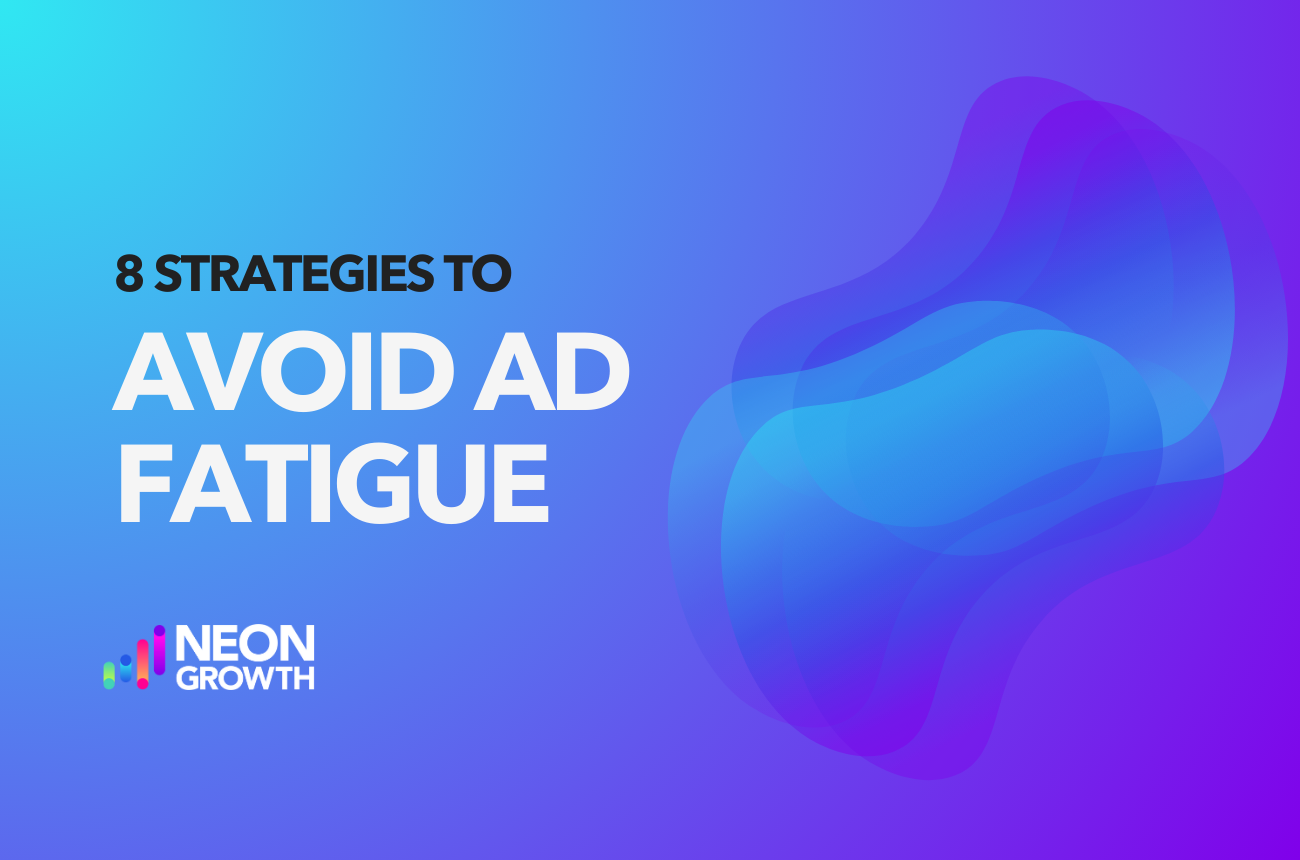
Eight Strategies to Avoid Ad Fatigue
We've already covered what ad fatigue is and how to spot it, but how do you prevent it?
Long story short, avoiding tired ads requires ongoing effort and attention to detail.
Below are 8 of our most effective strategies for avoiding creative fatigue in your ad campaigns.
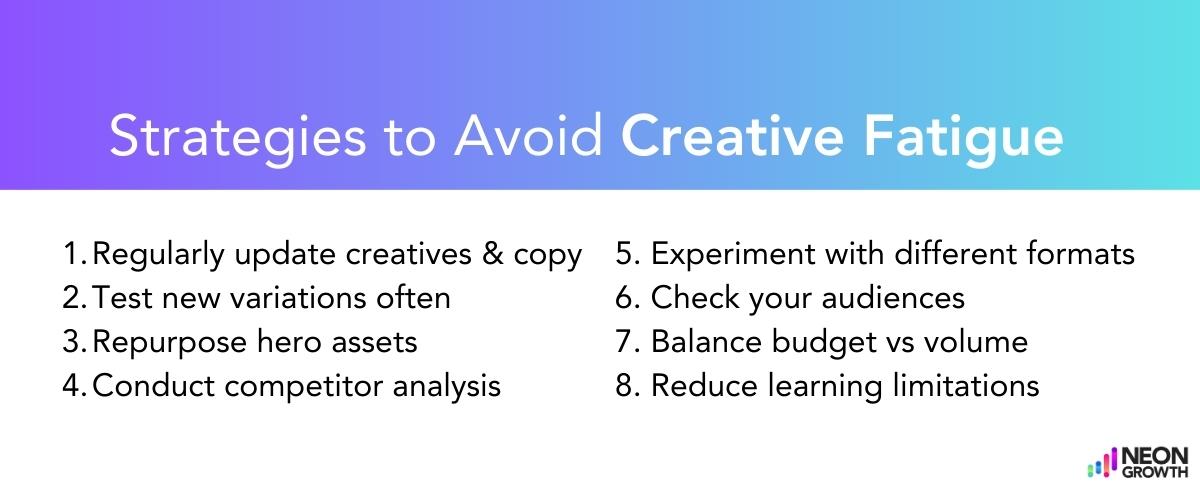
1. Regularly Update Ad Creatives & Text Captions:
The best way to avoid ad fatigue is clear: regularly update the ad creatives with fresh and engaging visuals.
You don’t need to start ad sets from scratch each time. Just make sure you are cycling in a few new creative styles alongside your existing top ads. This helps ensure the ad channel serves more variety and has assets on hand to prevent fatigue.
New visuals aren't always a constant possibility, though. While ad text holds less impact compared to visuals, copy edits can help keep things fresh. Copy tests prove especially useful in between larger creative updates.
Test USPs and phrasing as a method to reinforce different product benefits. Tracking copy performance helps to identify new hooks and angles to try in creatives. You can also experiment with alternate calls to action (CTAs) like Learn More or Get Offer. Other ideas include new promotional text, different copy lengths, different text formats like bullets, and emojis.
2. Repurpose Hero Assets
Repurposing hero assets is a great way to refresh creatives and prevent ad fatigue. Here are a few ways to repurpose top-performing assets:
- Trim videos to showcase different elements.
- Change up ad copy and subtitles/overlays.
- Lead with different elements.
- Apply the winning elements to a new ad format.
- If your hero is a video, try distilling the core content to a static or carousel.
- If your hero is an image, try visualizing the message.
- If your hero is a UGC, try mashups incorporating branded content, or multiple UGC assets. - Try new audiences.
- Try posting UGC using whitelisting.
- Apply seasonal or promotional themes.
- Try different color themes or copy styles.
- Combine multiple strong assets in a mashup.
- Adapt assets for new channels using native best practices.
3. Test New Variations Often
The cost for making new ad variations and iterations is low compared to creating a whole new concept. Even micro adjustments help deepen your understanding of the audience’s key motivators. Just make sure your tests are well-designed and thought out clearly.
- Try different intros with different core content in videos.
- Test different copy angles with your creatives.
- Try emojis vs no emojis.
- Try captions vs no captions.
- Test different imagery and product angles.
- Mention different benefits and features.
- Show unique and specific use cases.
- Try relating to different segments of your audience.
- Try saying it in a video, a static, or use a UGC.
Structured A/B testing and experimentation can help identify which ad creatives and copy variations resonate. Creative testing data helps inform ongoing optimization, increase effectiveness, and avoid fatigue.
It is important not to lose sight of audience preferences and demographics when testing. New creative is important, but so is relevance. Make sure your creatives match your prospects and continue to monitor engagement metrics.
4. Conduct Regular Competitor Analysis
Staying on top of your industry helps generate informed advertising decisions. You don’t want to copy your competitors, but instead outshine them. Getting a little competitive inspiration can provide valuable insights and ideas for fresh ad creative.
See what other businesses in the industry are doing with their campaigns:
- What appears to be working for them?
- What hooks and angles are they testing?
- What formats are they leaning in to?
- What can you do better or differently?
5. Experiment with Different Ad Formats
Ad algorithms prefer to serve the ad format users are most likely to engage with. For example, some users only click on video ads while ignoring static ads. The ad rotation delivery mechanisms read into this behavior and the respective user’s feed looks different than other feeds.
In order to increase your reach, maintain asset liquidity across multiple formats and placements. Creative liquidity means using a diverse mix of assets (statics, square video, vertical video, carousels, etc.) This allows you to lower your bid threshold for serving that specific impression.
Experimenting with different ad formats also helps keep ad campaigns fresh and interesting. Ad platforms often launch new formats as well, so staying on top of trends can give you a competitive edge.
6. Check Your Audiences
Periodically examine your audiences to make sure there isn’t a larger problem. Check saturation metrics if available on the ad platform. Look into your overall audience size, and check that applied audience exclusions aren’t unnecessarily straining your pool of prospects.
Some ways to tackle audience fatigue include expanding your targeting, adding additional interests or geographies, or utilizing lookalikes. For narrow audiences, reducing the budget may also help prevent wasted spend.
If you see high frequency despite having low audience saturation, try excluding recent page/app and site engagers. This can encourage the algorithms to expand to more people.
7. Balance Budget versus Volume
In your battle against stale ads, don’t forget to balance the need for new with your unique goals and resources. Consider your budget when implementing strategies to avoid creative fatigue.
Cranking out ad creatives can be costly depending on your internal (or external) creative process. An advertiser spending millions per month has very different creative needs versus an account spending a few thousand. Monitor your frequency as you scale up your budget to find the sweet spot.
8. Reduce Learning Limitations
Updating and making significant edits sends your ads back into learning periods. This happens as the algorithms recalibrate and reevaluate audience attributes in response to your changes. Even a simple text edit can greatly impact who will resonate with that message.
Each time you make a significant ad change, it may take a couple of days to get out of learning phases. Campaigns with smaller budgets or fewer average conversions may take longer. If you re-enter learning too often, your budget may be spent inefficiently.
It’s typically best to batch these refreshes in ad copy and creatives. For ROAS or CPA-optimized campaigns, avoid making daily updates. Instead, monitor, analyze and strategize the changes, then deploy your updates in a batch. Our team frequently schedules these updates during periods of low-activity for your users.
Likewise, testing too many creatives across ad sets can spread smaller budgets too thin to gather enough conversion data. A good rule of thumb is 5 ad creatives per 100 conversions. For high AOV products, this might not be achievable, so we implement custom calculations based on impressions and other metrics.
At Neon Growth, our media buyers and creative strategists employ regular campaign audits to identify and prevent creative burnout. In fact, it’s one of our specialties.
We work closely with our clients to develop robust creative diversity using efficient modular and iterative strategies. Identifying new audiences, regularly testing copy, and structuring research-based messaging tests keeps ads fresh. We also utilize A/B testing and experiment designs to identify current winning elements and new angles.
Case Study: Home Electronics Brand
A new client came to us for paid social and paid search support. In the 3 months prior to working with us, their campaigns featured a small number of hero creatives. We identified signs of creative fatigue, with ads seeing high frequency and declining engagement.
To tackle this challenge we:
- Launched an in-depth audit, identifying key historic assets with potential for optimization.
- Refreshed campaigns swiftly using rapid asset creation tactics, netting immediate improvements.
- Developed new creative tests based on audience research and personas. This ensured the creative pipeline was prepared for increasing scale.
- Restructured search campaigns to increase non-brand volume, utilizing new copy angles.
Within 3 months, our client saw 5.5x more purchases, with 82% higher ROAS.
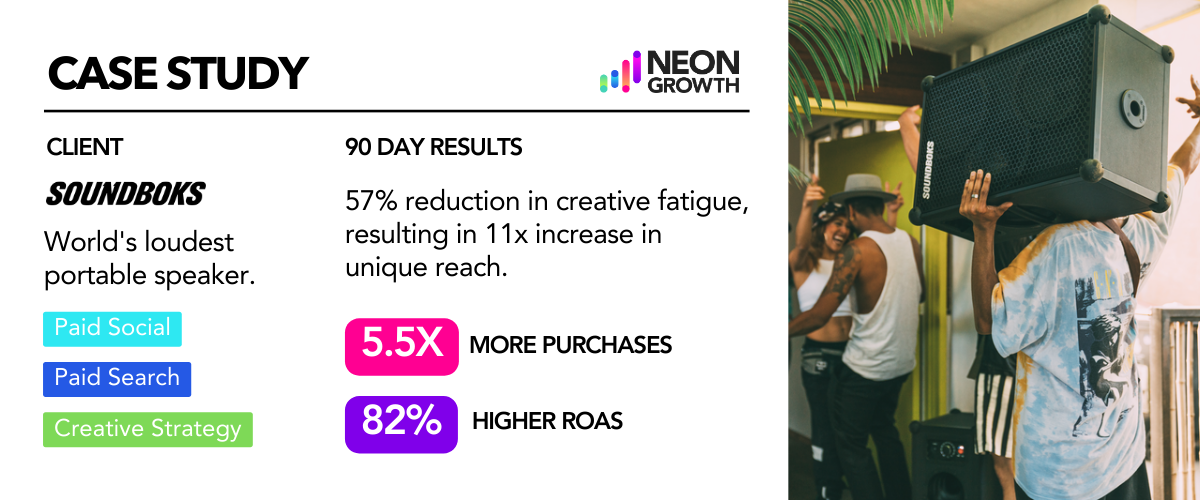
Wrap-Up
Creative fatigue is a common issue in digital advertising, affecting campaigns on every channel. However, businesses can avoid creative fatigue and achieve better ad campaign performance by:
- Regularly updating ad creatives and copy.
- Monitoring campaigns for key KPIs like frequency.
- Testing new variations and elements in creatives.
- Using a variety of ad formats and creative styles.
- Staying up-to-date on emerging trends and technology.
Partnering with an ad agency also provides valuable expertise and support in optimizing campaigns against fatigue. At Neon Growth, we specialize in helping businesses achieve better ad campaign performance by avoiding creative fatigue.
Want to learn more? Get in touch today to learn how we can help your business achieve its advertising goals.
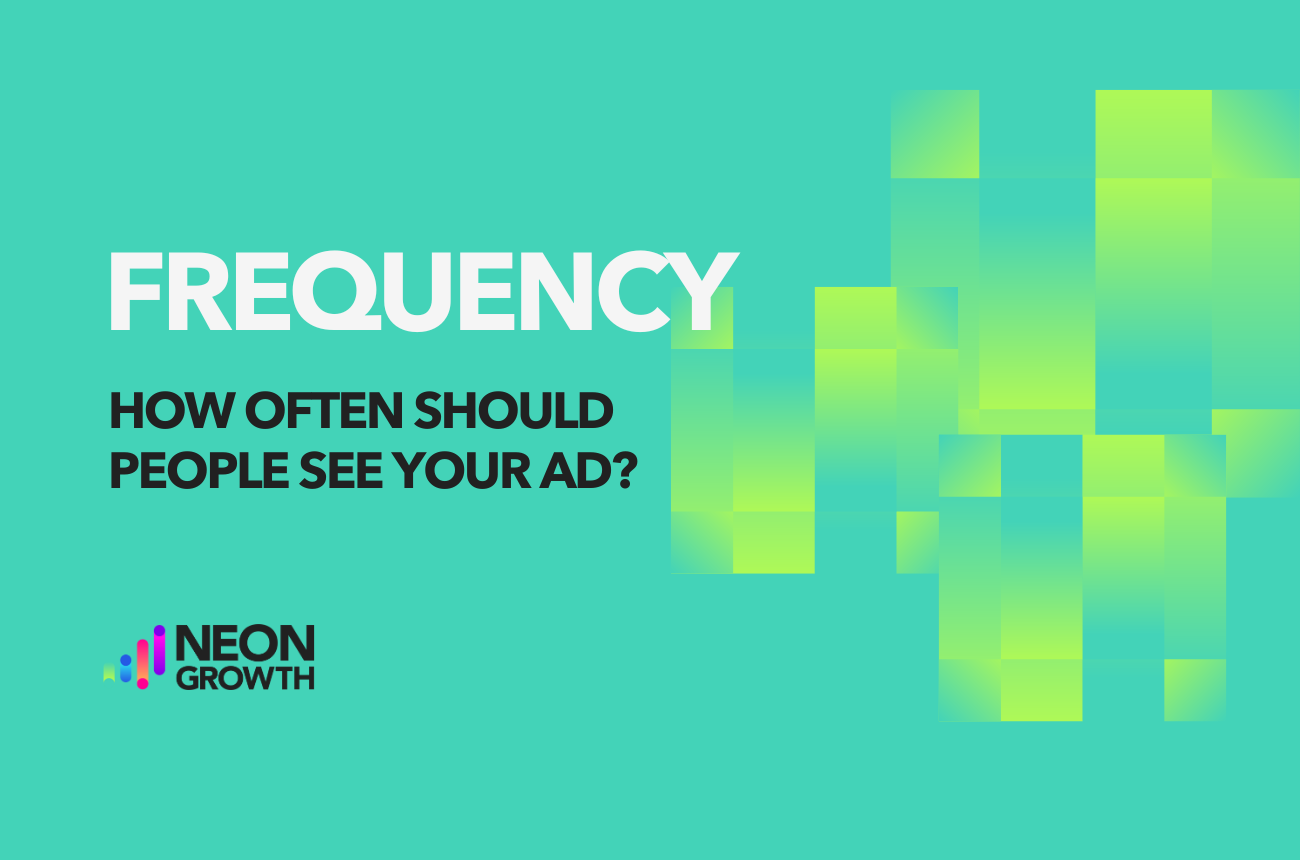
Frequency: How Often Should People See Your Ad?
Frequency refers to how often your audience is being shown your ad in a given time frame.
As your audience sees the same ad creative multiple times, they tend to develop “ad blindness”. While it can take a few exposures to grab attention, there is a point of diminishing returns. Meaning, you’re not likely to see more results by continuing to run the ad. Aka wasted budget.
Meta research finds that after 4 repeat exposures, click-through rates (CTR) drop by 40%. Even more concerning, conversion rates (CVR) drop by 60% after 4 consecutive views by the same user. Meaning, the first impression is approximately 316% more effective than the fourth impression. This is exactly why our team takes a highly proactive approach to managing ad frequency.

The ideal frequency in digital marketing varies significantly by industry and price points. For example, a niche high-ticket item will likely require higher frequencies to account for a more lengthy consideration phase. Inexpensive items with mass audience appeal typically have less complicated buying decisions, and lower frequencies.
Audiences may also fatigue, especially when served stale assets for a long time. This occurs most often with narrow audience sizes. There are also different time frames to consider, but more on this later.
How Often Should People See Your Ad?
The most important metric to understand when diagnosing creative fatigue is frequency. Frequency estimates the average number of times a person sees your ad in a given time frame. It’s calculated by dividing impressions by reach.
For prospecting campaigns, a frequency between 1 to 2 is considered optimal (over a 7-day period). A study by Facebook found a 7-day frequency of 1 captured 80% of potential brand lift. Increasing to a frequency of 2 captured 95% of potential brand lift.
Another analysis of over 10,000 ads by Social Media Today suggests a frequency between 1.8 to 4 to balance increasing CPAs.
In retargeting campaigns, this metric ranges higher as the audience is generally smaller. Repeated exposure is also valuable for receptive mid- and bottom-funnel audiences.
High frequency may be useful in cases where you’re trying to build brand awareness and recall. Holiday seasons, short burst campaigns and new offerings also benefit from higher exposure strategies.
In some ad platforms, you can apply a “frequency cap” to limit the number of times a person sees an ad. But, this is typically only recommended for reach and awareness campaigns.
Optimal 7-Day Frequency by AOV
Overall, factors that influence frequency include your potential audience size, budget, and scheduling. When this metric rises, your audience may be too narrow, or the budget may be too high for the audience size. Narrowing when your ad gets shown may also limit the diversity of users.
If an ad with high frequency is otherwise hitting your KPI targets, no need to be alarmed. But, be aware that creatives do typically fatigue faster as exposure increases.
Frequency Windows: Applying Date Ranges Effectively
The most commonly used timeframe for assessing frequency is a 7-day period. This tells you on a week-over-week basis how your creatives trend. The benchmarks of 1-2 for prospecting and 2-3 for retargeting are based on the 7-day window.
Lifetime frequency helps reveal the overall runway your ad creatives have left. Lifetime values also share insights into audience fatigue.
Generally, a lifetime retargeting frequency around 4 to 6 is considered a good benchmark to avoid diminishing returns. For retargeting, Wordstream found increasing conversions with up to 6 ad exposures, but declining CVRs afterward. Other research indicates CTR drops as much as 50% after a lifetime frequency of 9.
1-day frequency is primarily mostly useful for high-budget ($25K+/day), short duration campaigns. If you significantly increase budgets during a holiday campaign for example, it's important to monitor frequency to spot early creative burnout.
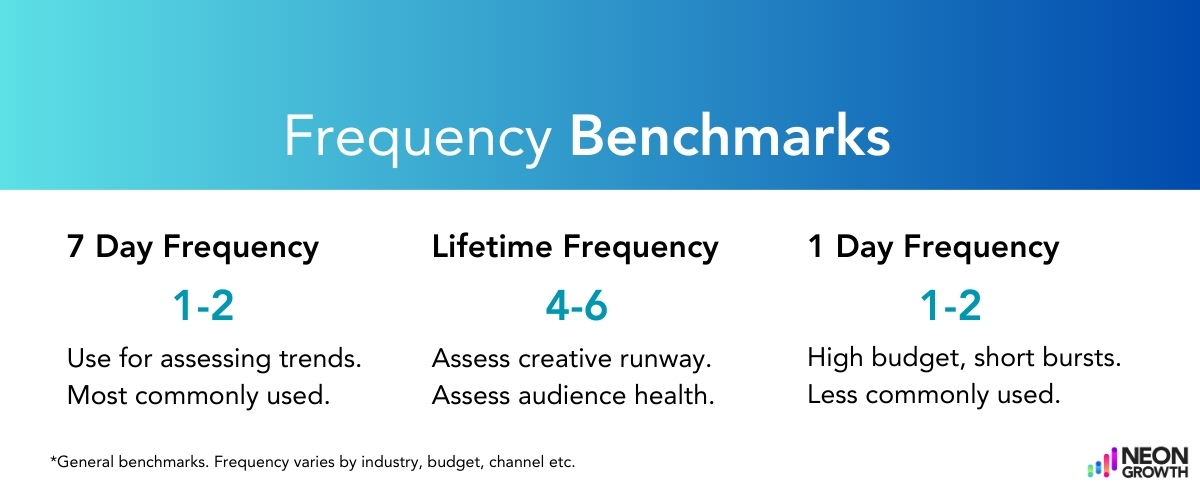
Want to learn more? Get in touch today to learn how we can help your business achieve its advertising goals.
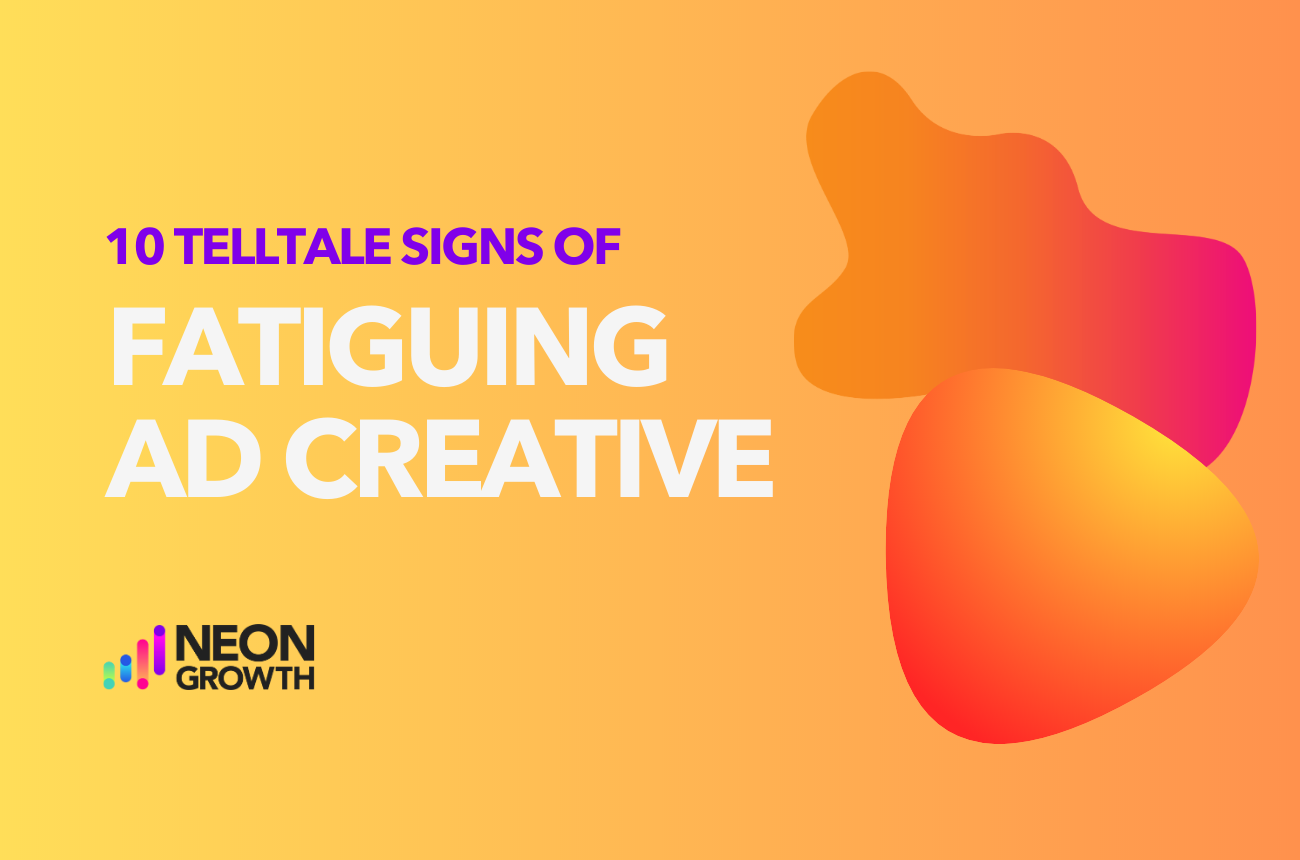
Ten Telltale Signs of Fatiguing Creatives
Most paid social, paid search, and programmatic platforms provide important metrics marketers can use to identify ad fatigue. It's important to monitor and check critical metrics to understand and identify trends.
Here are the ten key warning signs of ad fatigue that you should look out for:
1. Increased Ad Frequency
An increasing frequency trend indicates an asset is being shown more often to the same audience.
2. Decreased Thumbstop Ratio
A significant downward trend in 3s view-through rates indicates users are skipping past the ad faster.
3. Decreased Click-through Rate
A sustained downward trend in link clicks indicates less desire to act.
4. Increased Cost-per-Click (CPC)
Typically caused by lower CTR and engagement. Higher CPCs may also result from increasing CPMs as the audience saturates.
5. Decreased Conversion Rates
A sustained decrease in conversion is inevitable from fatigue. Clicks may be more from annoyance than interest.
6. Increased Costs-per-Action
As CPCs increase and CTRs decrease, costs to acquire a conversion typically go up.
7. Decreased Video View Thru Rate
A drop in viewers watching your videos to completion indicates less sustained interest.
8. Decreased Engagement
A slowdown in likes, shares, or comments may mean people don’t feel compelled to interact.
9. Negative Feedback
An increase in negative comments or dislikes can indicate an advertisement no longer resonates.
10. Declining Quality Scores
A dip in platform ad quality scores without changes to the creative or landing pages also indicate fatigue.
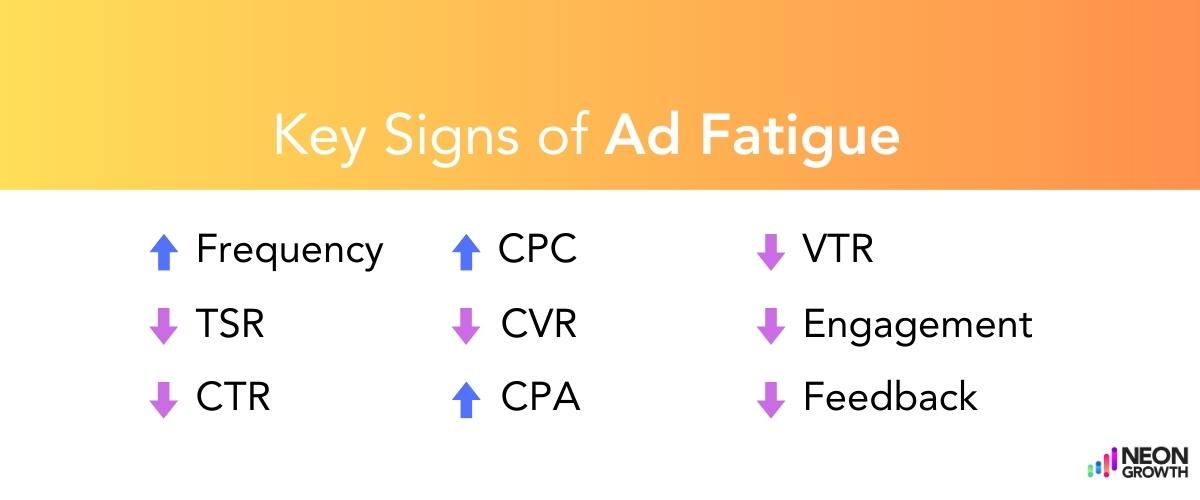
Beyond the Creative: Audience-Level Fatigue
When using small or narrowly targeted audiences, the user group itself might eventually fatigue. At some point, even creative changes may not be enough to get that group of people engaged in your offer. Or, they may just need some space.
From Facebook’s Ad Manager, you can access the “Inspect” tool. Here, you’ll find useful data for diagnosing both ad and audience fatigue. The Audience Saturation panel provides the following data on ad sets with at least 3 days of results:
- Audience Lifetime Frequency: View the lifetime frequency trend of this ad for your audience, alongside cost-per-purchase trends.
- First Time Impression Ratio: View the percent of daily first-time, new impressions versus repeat impressions. If it's trending lower, time to look closer. This should ideally be more than 25%.
- Lifetime Reach: The number of users this ad set has reached at least once over its lifetime.
- Lifetime Audience Reached Ratio: View the estimated percentage of the total estimated audience that your ad set has reached. This should typically be under 50%.
- If both Lifetime Audience Reached and Frequency trend high, continuing to drive budget to this audience may not yield incremental value.
To locate this Facebook ad fatigue data, navigate to view the Ad Set level dashboard in Ads Manager. Hover over the Ad Set you want to assess, and click the “Inspect” link under the ad set name. From the Inspect panel, select “Audience Saturation” to find the above metrics.
Regularly monitor key performance metrics like frequency, CTR, and CVR to spot ad burnout. Proactivity helps prevent stagnant creative from dragging down campaign performance. Fresh ads also keep your potential audience more engaged.
Want to learn more? Check out our Guide to Creative Liquidity and 8 Strategies for Avoiding Ad Fatigue.
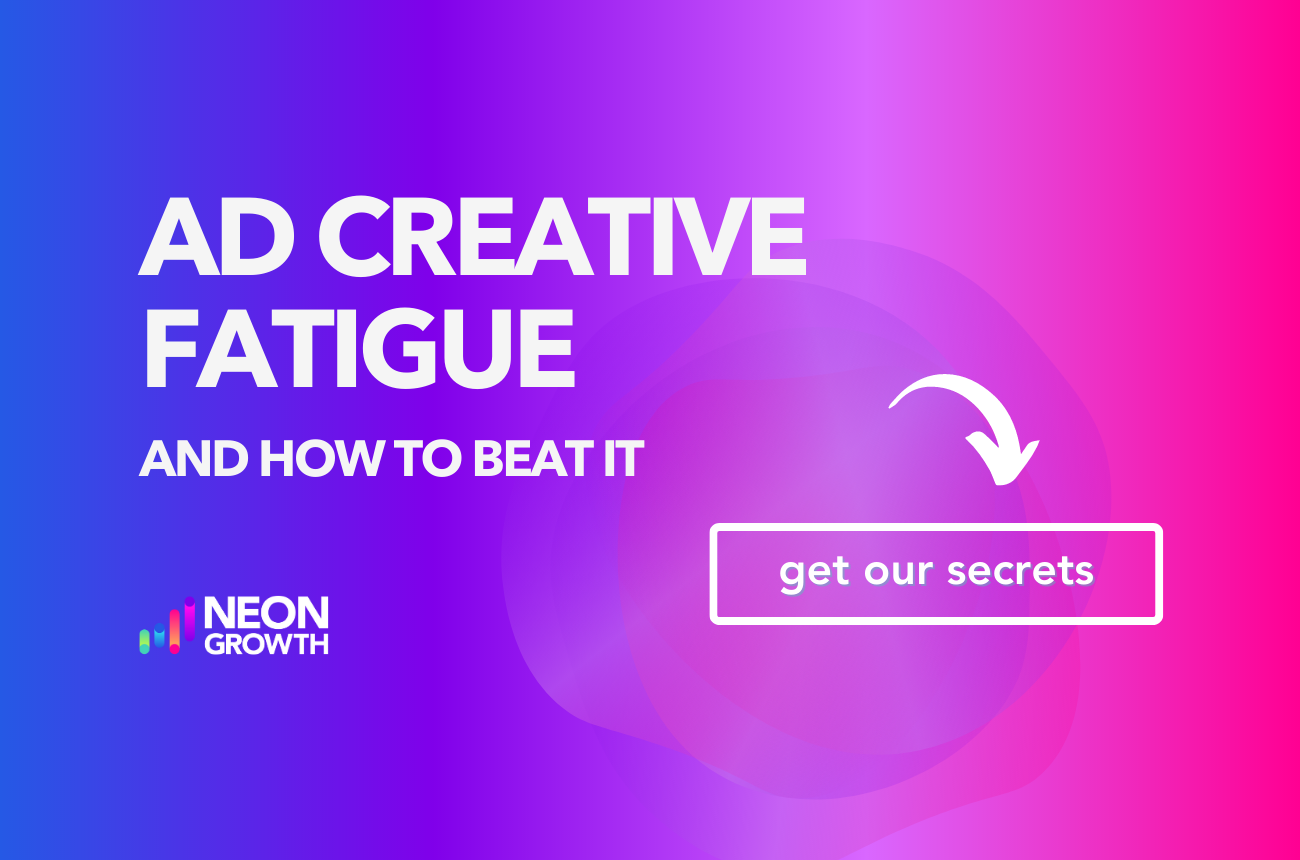
Why Ad Creative Fatigue Happens and How to Beat It
Ever wonder why that hero, formerly crushing every metric, suddenly falls off a cliff?
You check your campaigns - everything is in order. Your landing pages haven’t had any changes. Pixels are firing properly. So, what gives?
If you haven’t updated your ad creative in a while, you’re likely experiencing ad fatigue. Fortunately, this common problem is solvable with ongoing effort, attention to detail and fresh ads.
In this article, we will explore what causes ad creative exhaustion. We’ll also provide strategies for avoiding it and share how we prevent creative burnout for our clients.
Understanding Ad Fatigue: Human Behavior
Creative fatigue is a pretty common issue in digital advertising. It occurs when ad creatives become stale and begin losing their effectiveness.
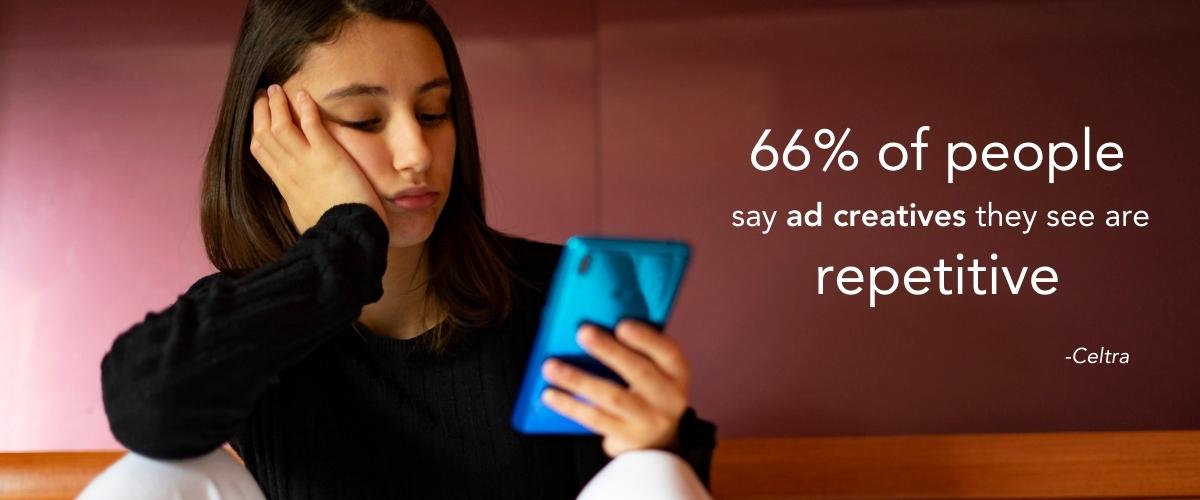
This issue stems from our human preference for novelty and newness. After we’re exposed to something many times, we lose interest. In the age of endless scrolling, this issue is only becoming more important for advertisers to tackle head-on.
In a survey of 1000 US consumers by Celtra, 66% of people found brand creatives repetitive. 44% reported being annoyed by ads they’ve seen too many times. Similarly, a 2019 survey by Kantar found that 73% of British respondents reported seeing the same ads multiple times.
Repeated ad exposure does have the effect of helping aid brand recall. However, at a certain threshold, the incremental value of paying to show the same user an ad drops. After many repeat exposures, viewers may even get upset at advertisers. Certainly not the goal!
What Causes Creative Fatigue?
Several factors contribute to ad campaigns fatiguing and losing effectiveness over time.
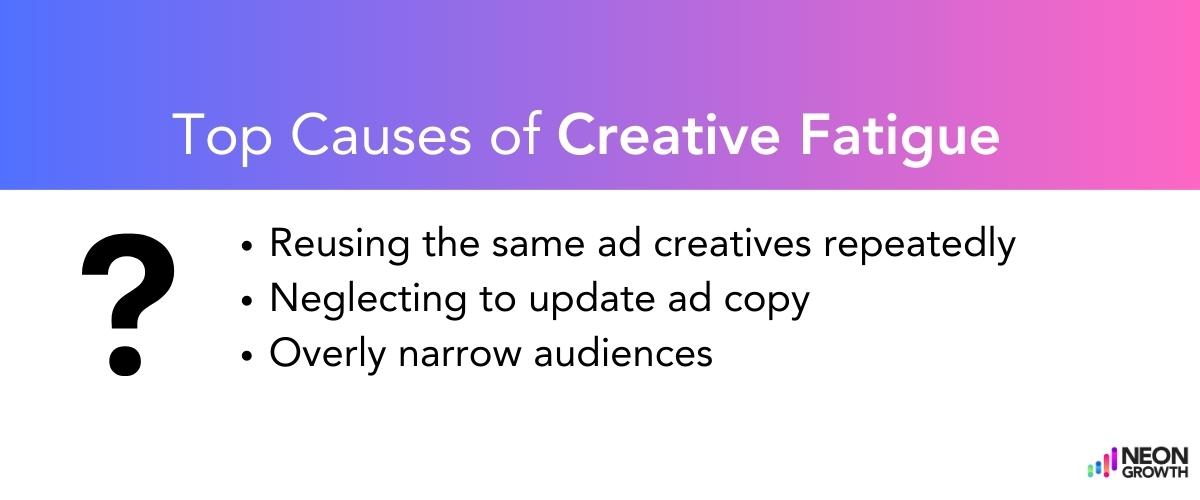
The most common cause of creative fatigue is using the same ads too long. Over time, ads lose their impact on the target audience. This leads to reduced engagement rates, lower click-through rates, and ultimately, decreased conversion rates.
Neglecting ad copy also contributes to ad fatigue. Ad copy is less important than visuals, but still plays a crucial role in conveying product benefits. Old, stale text captions are a missed opportunity and low hanging fruit.
Overly narrow audiences also force ad platforms to show your ad to the same people repeatedly. Always check your projected audience size and make sure it’s in sync with your budget.
The Negative Effects of Ad Fatigue
Creative fatigue yields several negative effects on ad campaigns. Typically, when ads approach exhaustion, you’ll start to see declines across key metrics.
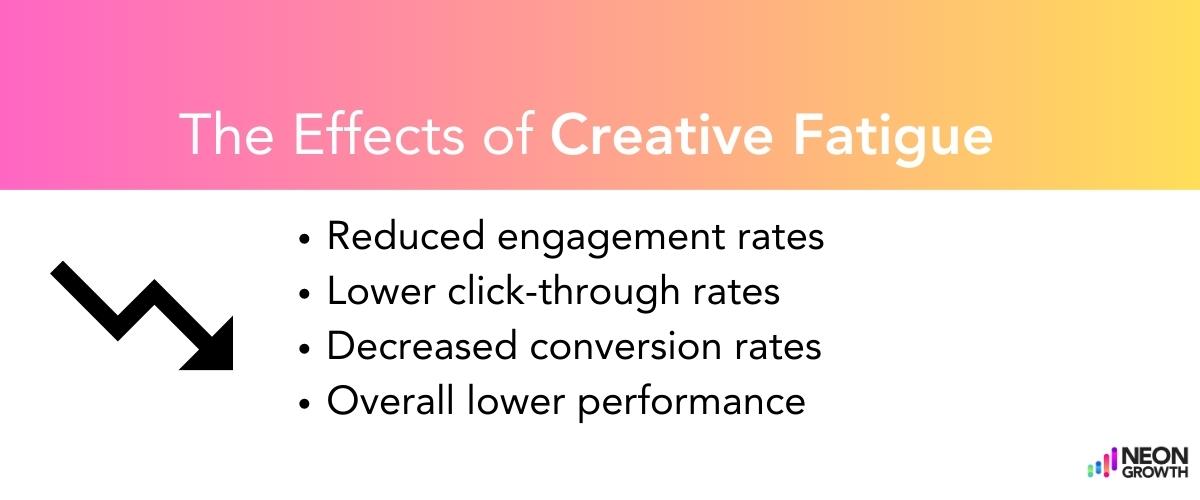
One of the most significant effects is reduced engagement rates. When ad creatives and copy become stale and lose novelty, people find them easier to ignore.
When people engage with ads less, they also click less. Thus, lower click-through rates are also a common negative effect of creative fatigue.
Fewer people clicking on ads means fewer opportunities for conversions. Fewer conversions ultimately result in a lower return on ad spend.
At Neon Growth, our media buyers and creative strategists employ regular campaign audits to identify and prevent creative burnout. In fact, it’s one of our specialties.
We work closely with our clients to develop robust creative diversity using efficient modular and iterative strategies. Identifying new audiences, regularly testing copy, and structuring research-based messaging tests keeps ads fresh. We also utilize A/B testing and experiment designs to identify current winning elements and new angles.
Case Study: Home Electronics Brand
A new client came to us for paid social and paid search support. In the 3 months prior to working with us, their campaigns featured a small number of hero creatives. We identified signs of creative fatigue, with ads seeing high frequency and declining engagement.
To tackle this challenge we:
- Launched an in-depth audit, identifying key historic assets with potential for optimization.
- Refreshed campaigns swiftly using rapid asset creation tactics, netting immediate improvements.
- Developed new creative tests based on audience research and personas. This ensured the creative pipeline was prepared for increasing scale.
- Restructured search campaigns to increase non-brand volume, utilizing new copy angles.

Want to learn more? Get in touch today to learn how we can help your business achieve its advertising goals.
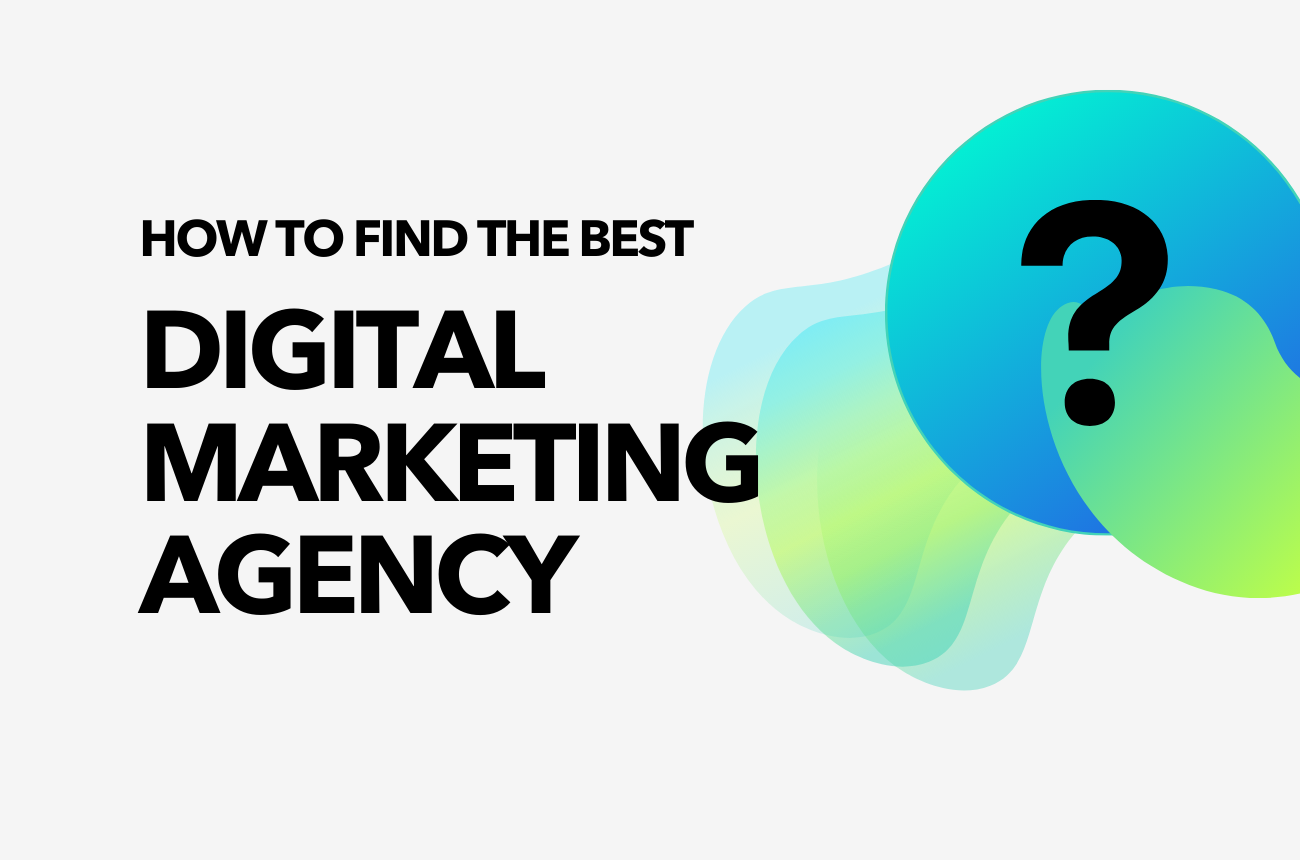
Don't Settle: How to Choose a Digital Marketing Agency
Digital marketing agencies play a crucial role in helping businesses succeed online. Choosing the right partner makes all the difference in your company's growth and success.
But with so many options available, it can feel overwhelming to decide who you should partner with. In this article, we'll explain what a digital agency is and services they offer in detail. We’ll also explain how to find the right agency for your business.
In This Article:
Part 1: Understanding Digital Marketing Agencies
Part 2: The Benefits of Hiring an Agency
Part 3: Marketing In House versus Agencies
Part 4: Before You Begin: Get Clear on Your Goals
Part 5: Eight Questions to Ask a Potential Agency
Part 6: After the Deal: How to Measure Success
A digital marketing agency is a business that provides web-based advertising services to help clients achieve their online goals. Sometimes, they’re also referred to as a digital marketing company or an online marketing agency.
By leveraging their expertise, advertising firms help businesses increase their online visibility, drive traffic, and convert leads into customers.
There are partners for businesses of all sizes, from small startups to large corporations. Agencies also come in all sizes, from independent freelancers to midsize firms and even global conglomerates.
Types of Digital Marketing Services & Agencies
Since the digital space encompasses a multitude of disciplines, agencies span many service categories. Some of the services offered by digital service companies include:
Paid social media marketing: paid advertisements on social channels like Facebook, Instagram, Tiktok, Pinterest, Reddit, and Twitter. Agencies might offer media planning and buying, ad content creation, creative strategy, influencer services, technical support services, and more.
Paid search marketing: paid search results and pay-per-click advertising on platforms like Google Search Ads and Bing. Also referred to as search engine marketing (SEM), paid search promotion captures traffic on search engines and display networks. You might also see this described as pay-per-click (PPC) advertising, which can refer to multiple types of channels.
Organic social media management: overseeing brand social media accounts and creation of organic content for social media platforms.
Search engine optimization (SEO): website content optimization for search engine discovery. SEO aims to improve your search rankings and drive more traffic to your site using content and other tactics.
Influencer marketing: utilizing social media and website influencers to promote brands and content. Influencer advertising can involve things like product giveaways, organic content, paid content, affiliate programs, and more.
Web design: concepting and developing website designs, conversion rate optimization, and user experience.
Additional categories managed by digital agencies could include:
- Email and SMS
- Connected TV
- Programmatic and Display Ads
- Content Marketing
- Podcast and Audio
- And much more.
Most digital agencies will fall into one of four categories: full-service, specialized, boutiques or growth. These categories are based on the scope of services offered and the team’s size.
Full-Service Agencies
Full-service agencies offer a comprehensive range of marketing services, acting as a one-stop shop for all digital needs.
Their services could include paid social ads, influencer marketing, paid search, SEO, web development, conversion rate optimization, marketplace ads, connected TV, and everything in between. Each company will have its own assortment, depending on the industries they service.
A full-service provider can provide a cohesive, integrated approach. However, they may be significantly more expensive and less agile compared to smaller agencies.
Specialized Agencies
Specialized agencies, on the other hand, focus on specific areas, like SEO or perhaps a specific channel like TikTok. Specialist agencies provide in-depth knowledge and expertise in their chosen niche.
Since they target one narrow scope, they can bring advanced knowledge and tactics. But, they may lack the ability to address complex business challenges, or to approach your marketing strategy holistically.
Boutique Agencies
Boutique agencies tend to be smaller in size and offer personalized, tailored services to a limited number of clients. Boutiques tend to focus on specific verticals, such as apparel or mobile gaming. They can be either narrowly specialized or may provide a full range of services.
A boutique digital agency can deliver a highly customized experience and close working relationships akin to in-house teams. They also tend to be able to adjust and adapt to market trends swiftly. But, smaller teams may have resource limitations as brands scale.
Growth Marketing Agencies
A growth marketing agency typically takes a more holistic, data-driven approach. Their focus is on scaling businesses. Growth marketing encompasses the full digital funnel. This includes paid social and search, ad creative, SMS & email, as well as website optimization.
The growth agency approach brings similar benefits to boutique and full service options. Growth teams may also employ specialized experts, with more experience than typical agencies.
Usually, a growth team relies on business goals, KPI-tracking and analysis to lead strategy vs solely branding and awareness objectives. If your business is trying to increase sales, enter new markets or takes a data-centric approach, a growth agency may be the right choice.
Weigh both the services you need and the type of team you want to work with. This will help you get a clear picture of who may be a good fit.
What do digital marketing agencies do?
Each company works differently depending on what services they offer, the industry they are in, and their relationship with the client.
Generally, an agency will provide campaign strategy, planning, execution, and analysis. Some may also make the advertising assets (both copy and visual content). Advanced data services like attribution and forecasting may also be in-scope.
Digital Strategy: Media Planning & Media Buying
One of the primary services offered by modern digital ad agencies is developing a comprehensive digital strategy. This includes identifying your target audience and determining which channels to use to reach them. Your partner may also develop the plan of how to execute your marketing campaigns in.
Media planning and media buying are also crucial components of strategy. Media planning involves selecting the best channels to use for your campaigns. Media buying involves purchasing ad space on these channels to reach your target audience.
Content Creation: Creative Strategy & Execution
Creating high-quality, engaging content is another essential aspect of online promotion. Research suggests up to 70% of digital campaign success depends on the advertising creative.
Agencies typically help develop a content strategy for the channels that they manage. The primary role here is developing creative that aligns with your brand and resonates with your target audience.
In addition to creating content, agencies may also help you optimize your website for both conversion performance and search engines. Optimizing websites for conversions makes all traffic more efficient and improves overall results. Search optimization helps your website drive relevant customers and improve organic traffic.
Making Sense of the Numbers: Data, Analysis & Technology
An agency’s role typically doesn’t end with campaign execution. To measure the success of your efforts, it's important to track and analyze data.
Digital marketing agencies often use tools to collect data on your ad campaigns, website traffic, social media, and more. They then use this data to make informed decisions about how to optimize your campaigns for better results.
In a constantly evolving technological environment, agencies also help clients keep up with changes in trends and technology. For example, ongoing data privacy changes significantly changed the way social media marketing works. An advanced agency can help brands adjust and adapt swiftly to these trends.
- Deep Expertise & Experience
- Access to Resources & Tools
- Cost Efficiency
- More Internal Resources
One of the primary benefits of hiring a digital service agency is access to their expertise, experience, and resources. As specialists in the field, agencies stay up-to-date with the latest industry trends and best practices. This knowledge allows them to create and implement effective marketing strategies.
Additionally, agencies’ work with many clients across different industries, garnering valuable insights. Their experts can provide data-backed recommendations tailored to your business. By leveraging the resources and tools that agencies have at their disposal, businesses gain a competitive edge in the digital landscape.
The cost and value of hiring a digital marketing agency is often misunderstood. Many businesses assume it’s more expensive than managing efforts in-house. When you factor in the costs of hiring, training, and retaining a full-time marketing team, costs add up fast. Ultimately, outsourcing marketing services can often be more affordable.
Working with a good partner also frees up time and resources for other aspects of your business. By outsourcing marketing tasks to professionals, business owners, and employees can focus on their core competencies. This allows internal teams to dedicate more time to developing other areas of the business. More efficient allocation of resources often leads to improved overall productivity.
Furthermore, digital marketing agencies are results-driven, as they have to perform to retain clients. A strong agency team is focused on delivering the best possible return on investment (ROI). Their key goal is ensuring your advertising budgets are utilized effectively.
Managing a digital marketing team in-house does have its advantages. For example, holding direct control over all strategies and decisions.
Your team also brings a deep understanding of your brand. In-house teams can ensure that efforts are aligned with the company's vision and culture. Additionally, they can provide quick responses to changes and issues that arise.
However, several challenges arise when managing all advertising in-house.
Primarily, you need to hire, train, and retain a full-time team. This can be costly and time-consuming, especially if you’re not an expert at recruiting in this field. It takes many years to develop in-depth knowledge in each marketing discipline. Experience often commands competitive salaries as well.
In-house teams and junior marketers may lack the specialized expertise needed to execute certain tasks effectively. They may also have a narrow scope of experience when it comes to current tactics and technologies. These limitations can impact the success of your campaigns.
Working with an agency allows you on-demand access to a team of experts with diverse skill sets. Additionally, outsourcing can be more cost-effective. You only pay for the services you need, versus maintaining a full-time team.
Agencies typically have access to cutting-edge technology and tools that may be expensive for individual businesses. As partners of ad platforms, top agencies also have access to more support, training resources, and advanced technology. By leveraging their knowledge and tools, agencies help you stay ahead of the competition and achieve better results.
Relinquishing some control may be a concern. But, the right partner will work to understand your brand and align with your goals. The advantages of partnering with the right agency often outweigh the drawbacks. Managed services remain an attractive option for businesses looking to enhance their online presence and drive growth.
When is it worth hiring an agency? And, when is it not?
While hiring an agency comes with several benefits, it’s not right for every company. A few considerations that can help you decide include:
- Your budget: If your marketing budget is limited, hiring a full-service agency may not be in-scope. However, you might still consider outsourcing specific tasks to a specialized or boutique company.
- Your in-house capabilities: Is your team already experienced and capable of all advertising tasks? If so, you may not need to hire a service. On the other hand, if your team lacks expertise in targeted areas, an agency provides valuable support and guidance.
- Your business goals: Is your business looking to expand sales rapidly, reach new markets, or improve performance? Then, working with seasoned experts can be a good investment. If your digital marketing strategy is already yielding good results, you might not need assistance.
- Your available time: Managing ad campaigns and staff takes a lot of time. If your team is stretched thin, they may be unable to devote the necessary time to marketing efforts. Outsourcing can help maintain momentum and keep the focus on core business activities.
- Flexibility and scalability: Does your business need to adapt to changing conditions, or unlock a new stage of growth? An agency can provide the necessary agility and know-how. If your marketing needs are stable and predictable, an in-house team may suffice.
When choosing a digital advertising service, it's important to consider your business goals and the services you need to achieve them.
For example, if you're looking to increase brand awareness on social media, a social media ad agency is the right choice. On the other hand, if you want to improve your search engine rankings, an SEO expert may be a better fit.
As a decision-maker, it's important to align your team on the following questions before you begin your hunt:
What are our primary marketing objectives?
- Identify the key goals you want to achieve. Perhaps you want to reduce customer acquisition costs or increase brand awareness. Or, maybe you need to drive website traffic, generate leads, or improve conversion rates.
Which marketing channels are most relevant for our business?
- Aim to get an understanding of the platforms and tactics likely to be effective in your space. How do you want to reach your target audience, or which channels do you think are your biggest opportunities?
What are our in-house capabilities?
- Take inventory of your team’s skills. This will help clarify what you need help with, and what makes sense to tackle internally.
What is our budget for digital marketing?
- Establish a clear budget for your goals. Remember to include both your marketing budget and how much you can afford to pay for an agency’s expertise. This will help you identify agencies that can deliver the services you need within your current price range.
What are our expectations for the agency's level of involvement?
- Do you need a full-service agency to manage all aspects of your digital strategy? Do you want a data-oriented growth team? Or, do you require specialists to focus on specific tasks? Do you want a partnership or a more prescriptive approach?
What is our timeline for achieving our goals?
- Set a realistic timeline for reaching your objectives to help you find a partner comfortable delivering results within your desired timeframe.
When screening potential agencies, it’s important to determine if they will be a good partner for your goals.
During the intro call, you’ll meet a representative who typically asks questions to define your business goals and needs. You’ll be able to learn about their services and ask them questions as well.
The right questions reveal valuable insights into an agency's expertise. You also want to learn about their communication style and ability to meet your specific needs. Eight critical questions to ask when finding an agency include:
- What is your experience working with businesses in our industry?
Understand the agency's experience in your industry. This helps you gauge their knowledge of your target audience and ability to create effective marketing strategies.
- What services do you specialize in?
Knowing the company’s areas of expertise can help you determine if they align with your specific needs and objectives. If you’re optimizing for LTV-based growth, but they specialize in branding, it might not be a match.
- How do you stay up-to-date with the latest trends and best practices?
This question reveals the agency's commitment to continuous learning and adaptation in the ever-changing digital landscape. Their tools and technologies offer insights into sophistication and the resources available to support your marketing plans.
- How do you measure the success of your campaigns?
Understand the agency's approach to tracking and measuring campaign success. This helps you ensure they are focused on delivering ROI in a way that aligns with your business.
- How do you handle potential challenges or setbacks in a campaign?
Discuss potential challenges and their approach to addressing them. This can provide insights into their problem-solving skills and ability to adapt.
- What is your communication and reporting process?
Clarify how the company communicates progress, shares reports, and addresses concerns. Alignment here is essential for establishing a strong working relationship
- What are your pricing models and contract terms?
Understand the agency's pricing structure and contract terms. Be sure you understand the actual service offering to determine if it’s a good fit for your budget and expectations.
- Can you provide case studies or examples of successful campaigns for similar clients?
Review case studies and past campaigns to understand their approach and style. Past work demonstrates the agency's track record and showcases their ability to deliver results. Consider it a red flag if they don’t have case studies or testimonials to share.
Ask these critical questions, and you’ll be prepared to evaluate potential digital marketing agencies. choose the one that aligns with your goals and requirements.
Once you’ve found a fit, measuring the impact of your new service provider is essential. After all, you need to determine if they are a good investment.
Start by setting clear, measurable goals for your campaigns, such as increased website traffic, higher conversion rates, or improved customer engagement.
Monitoring the key performance indicators (KPIs) that align with your goals is a clear way to track agency ROI. The KPI metrics you use will depend on the advertising services and your type of business.
If you’re trying to grow overall web traffic, you might track website analytics, such as unique visitors and bounce rates. If it’s social media ads for ecommerce, consider click-through rate and overall return on an spend. Likewise, for email marketing, you might be looking at open rates and link clicks.
Establishing those clear objectives upfront allows you to track progress. It also gives your new partner clear goals. And, it enables you to evaluate the agency's effectiveness in achieving your desired outcomes.
By consistently tracking these KPIs and comparing them to your initial objectives, you gain valuable insights. Monitoring KPI trends helps you gauge the success of your marketing campaigns. This data also reveals the agency's contribution to your overall business performance.
Regularly review campaign data and discuss results with your agency. Being informed enables you to make data-driven decisions and optimize your strategies. Staying engaged also allows you to further maximize the return on your investment in the agency's services.
Choosing the best digital marketing agency for your business
When it comes to choosing the best digital agency for your business, there are several factors to consider. Look for a provider that has experience working with businesses like yours and has a proven track record of delivering results.
Additionally, make sure the company offers the services you need to achieve your business goals. If you have a specific problem to solve in a niche space, you might want a specialist. But, if your marketing team has broad goals to 2X sales and needs advanced attribution, budget allocation guidance and high-level data insights, a growth marketing agency might be your best choice.
It's also important to find a team that you feel comfortable working with and that communicates well. Advertising is an ongoing process for every business. You'll want to find a partner you feel comfortable establishing a long-term relationship with.
Wrapping Up
In today's digital age, partnering with a top agency can help your business succeed online. By developing an informed strategy, creating quality content, and reporting on results, an expert agency can help you achieve your business goals. A little research will help ensure you partner with the right digital marketing agency for your business and goals.

arrow.svg)
